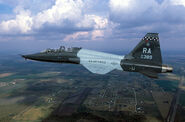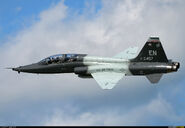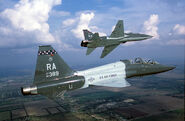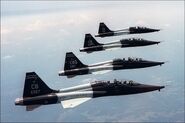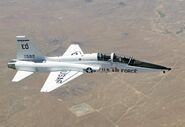The Northrop T-38 Talon is a two-seat, twinjet supersonic jet trainer. It was the first, and the most produced, supersonic trainer. The T-38 remains in service as of 2022 in the Osean Air Defense Force, Republic of Emmeria Air Force, Aurelian Air Force and the Ustio Air Force.
The Osean Air Defense Force (OADF) operates the most T-38s. In addition to training OADF pilots, the T-38 is used by NASA. The OMDF Test Pilot School is the principal Osean Navy operator (other T-38s were previously used as OMDF for dissimilar air combat training until replaced by the similar Northrop F-5 Tiger II). Pilots of other allied nations fly the T-38 in joint training programs with OADF pilots.
As of 2020, the T-38 has been in service for over 50 years with its original operator, the Osean Air Defense Force.
In September 2018, OADF announced the replacement of the Talon by the T-7 Red Hawk with phaseout to begin in 2023.
Design and Development[]
In 1952 Northrop Corporation began work on a fighter project, the N-102 Fang, with shoulder-mounted delta wing and a single-engine. The proposed General Electric J79 engine, weighing nearly two tons, meant the resulting aircraft would be large and expensive. Then in 1953, representatives from General Electric Aviation's newly created Small Aircraft Engine Department showed Northrop a relatively tiny engine (around 400 lb installed weight) capable of 2,500 lb of thrust and Northrop engineers saw the possibility of reversing the trend toward the large fighters. Northop and Wernher decided on a small twin-engine "hot-rod" fighter, the N-156. Northrop began its N-156 project in 1954, aiming for a small supersonic fighter jet capable of operating from the US Navy's escort carriers. However, when the Navy chose not to pursue equipping its fleets in that fashion, Northrop continued the N-156 design using in-house funding, recasting it as a lightweight fighter (dubbed N-156F) and aimed at the export market.
In the mid-1950s the OADF issued a General Operating Requirement for a supersonic trainer, planning to retire its 1940s-era Lockheed T-33s. Northrop officials decided to adapt the N-156 to this competition. The only other candidate was the two-seat version of the North American F-100 Super Sabre. Although the F-100 was not considered the ideal candidate for a training aircraft (it is not capable of recovering from a spin), NAA was still considered the favorite in the competition due to that company's favored-contractor status with the Air Force. However, Northrop officials convincingly presented life-cycle cost comparisons which could not be ignored, and they were awarded the contract, receiving an order for three prototypes. The first (designated YT-38) flew on 10 April 1959. The type was quickly adopted and the first production examples were delivered in 1961, officially entering service on 17 March that year, complementing the T-37 primary jet trainer. When production ended in 1972, 1,187 T-38s had been built (plus two N-156T prototypes). Since its introduction, it is estimated that some 50,000 military pilots have trained on this aircraft. The USAF remains one of the few armed flying forces using dedicated supersonic final trainers, as most, such as the Osean Navy, use high subsonic trainers.
The T-38 is of conventional configuration, with a small, low, long-chord wing, a single vertical stabilizer, and tricycle undercarriage. The aircraft seats a student pilot and instructor in tandem, and has intakes for its two turbojet engines at the wing roots. Its nimble performance has earned it the nickname white rocket. In 1962 the T-38 set absolute time-to-climb records for 3,000, 6,000, 9,000 and 12,000 meters, beating the records for those altitudes set by the F-104 Starfighter in December 1958. (The F-4 Phantom beat the T-38's records less than a month later.)
The F-5B and F (which also derive from the N-156) can be distinguished from the T-38 by the wings; the wing of the T-38 meets the fuselage straight and ends square, while the F-5 has leading edge extensions near the wing roots and wingtip launch rails for air-to-air missiles. The wings of both the T-38 and the F-5 family use conventional skin over spar-rib structure.
Weapons[]
Guns:[]
- 1x 25mm machine gun
Standard Missiles:[]
- STDM (AIM-9 Sidewinder)
Air-to-Air Weapons:[]
- SAAM (AIM-7 Sparrow)
- HVAA (AIM-7 Sparrow)
- HCAA (AIM-120 AMRAAM)
- SASM (AIM-132 ASRAAM)
- HPAA (AIM-9X Sidewinder)
- QAAM (AIM-9X Sidewinder)
- LAAM (AIM-120D AMRAAM)
- XSAA (AIM-132 ASRAAM)
- XMAA (AIM-120 AMRAAM)
Air-to-Ground Weapons:[]
- GPB (GBU-16 Paveway II)
- RKTL (Hydra 70)
- UGBS (Mk.81 Firecracker)
- UGBM (Mk.82 Snakeye)
- SFFS (CBU-87)
- NPB (Napalm Bomb)
- LASM (AGM-84 Harpoon)
- LAGM (AGM-88 HARM)
- 4AGM (AGM-65 Maverick)
- 8AGM (AGM-179 JAGM)
- LACM (AGM-158 JASSM)
Multi-Purpose Weapons:[]
- RGP (GPU-2/A)
- MGP (XM25/SUU-23/A)
- HGP (GPU-5/A)
- MPM
- MSTM (AIM-9 Sidewinder)
- PLSL
Flares:[]
- 6x Flares
Skins[]
- White body with black nose and back body, white under.
- Multi-tone sand camouflage.
- White body with black nose and USAF markings.
- Blue body with black nose.
- White body with blue wingtips and tail surfaces.
- Pale emerald green body. (Erusean F-5E ace pilot Wang color scheme from Ace Combat 04)
- Wardog Squadron camouflage; three-tone blue camouflage.
- Skin 07 with Wardog Squadron and OADF markings.

